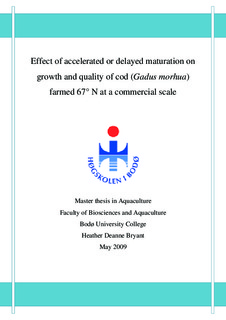Effects of accelerated or delayed maturation on growth and quality of cod (Gadus morhua) farmed 67°N at a commercial scale
Abstract
Abstract
Atlantic cod (Gadus morhua) farming has received considerable attention in recent years, and
is now becoming a rapid growing industry in Norway. This industry has shown
approximately 2,000 tons harvested in 2003 compared with approximately 13,500 tons in
2008. The harvest quantity is expected to increase by another 50% in 2009. The major
bottleneck for economical cod farming is with early maturation. In Atlantic salmon (Salmo
salar), light manipulation has been a successful method for avoiding early maturation, but
this has not been as effective in cod farming to date.
Two different light manipulation regimes were tried in commercial-scale cod production in
the north of Norway. The first regime (delayed group) had additional lights installed in the
netpens from August 17, 2007 until June 1, 2008. This treatment postpones the maturation by
2-3 months, with a peak spawning in June. In the second regime (accelerated group),
additional light was installed in the netpens from November 23, 2007 until June 1, 2008. This
treatment resulted in an accelerated spawning with a peak in February approximately 2
months before the untreated group. The maturation peak occurs approximately 4-6 weeks
earlier in males than in females. The impact on growth and quality is also substantially larger
among female cod.
The accelerated maturation resulted in a decreased gutted weight in February and an
enhanced increase in gutted weight from April. The lowest protein content (17.7%) in the
muscle tissue was also found in female cod in February. The mean HSI in females increased
from ~17% in December/February to ~20% in June. In female cod, the delayed maturation
showed an increase in gutted weight during the winter, with no further growth from the start
of maturation in April. The delayed group did not experience a decrease in muscle protein
content during maturation (19.7% in June), but instead a significant decrease in the HSI
content from ~17% in December/February to ~15% in June.
Description
Mastergradsoppgave i havbruk - Høgskolen i Bodø, 2009
